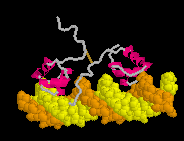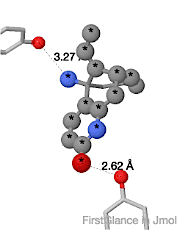User:Eric Martz/Protein 3D Structure Resources for Educators 2016
From Proteopedia
A Workshop for Educators at STCC
and other Springfield MA area colleges & schools.
by Eric Martz
Host: Dawn Tamarkin
1:00-5:00 PM, Monday and Tuesday, July 18 and 19, 2016
Springfield Technical Community College,
1 Armory Square, Springfield MA USA.
Building 2, Room 614
Get here with STCC.MolviZ.Org
Contents |
Background
- Introduction to Structural Bioinformatics and Genomics
- Why do we care about 3D macromolecular structure?
- What are 3D structure data?
- Where do 3D structure data come from?
- How much 3D structure knowledge do we have?
- What are the primary and derived 3D structure databases?
- World Wide Protein Data Bank
- What is the Protein Data Bank?
- UniProt.Org protein sequence database and a good place to find 3D models:
- Click on the blue Sequences button (left side of page) to get the full length of the protein chain.
- Click on the blue Structure button (left side of page):
- Are there any PDB codes?
- If yes: How much of the full length do they cover?
- If no, click on the code after Protein Model Portal to look for homology models.
- Detailed instructions: Practical Guide to Homology Modeling (includes how to look for empirical models before resorting to a homology model).
Major Jmol-Based Tools
- A protein structure encyclopedia "wiki" with interactive molecular scenes in Jmol.
- Green linked explanatory text changes the molecular scene.
- Tutorials on specific molecules and definitions/explanations of structural biology terms and concepts.
- Like Wikipedia, content is contributed by users.
- Customization of molecular scenes is supported with straightforward Molecular Scene Authoring Tools. See Make Your Own Tutorials.
- Unlike Wikipedia, authors are identified by their real names, hence receive credit and take responsibility.
- A user-interface to Jmol that makes it much easier to see major structural features of macromolecules.
- Used by Nature for its "3D" buttons in reports of new structures. Also by many other journals and bioinformatics resources.
- Does not support customization of the molecular view. You are stuck with standard color schemes.
- Easily saves static images or presentation-ready animations. Examples.
- What Is It? More.
Lesson Plan with Assessment (3 afternoons)
|
Enolase (4enl; an enzyme in glycolysis) evolutionary conservation from ConSurf. Catalytic pocket is highly conserved. | ||
|
|
||
- Introduction to Structural Bioinformatics 2016
- Designed for undergraduate biological science majors (4 hours/afternoon x 3 afternoons = 12 lab hours)
- Each student picks a different protein and does a report on how its structure supports its function
- Sample Completed Report Section 9 is obsolete since animations can now be saved directly from FirstGlance
Tutorials on Specific Macromolecules
- In a computer lab, I like to hand out a short list of somewhat vague, open-ended questions to foster discussion in small groups of students. See Worksheets.
- Most of these tutorials are in Proteopedia.Org, a wiki with user-authored content. Some articles are authored by students. As with Wikipedia, use your judgement. Unlike Wikipedia, authors' real names are at the bottom of each article and you can check their credentials by clicking on the names.
Molecules With Questions For Students (Java not needed)
- DNA. Español (B form double helix) - A Nonlinear Tutorial / Discovery Tool
- Lac Repressor binding to DNA and bending the operon. Questions for Students.
Molecules With No Questions ... Yet
No Java Needed
|
Potassium channel (1R3J) showing membrane surface planes (click Jmol at OPM). |
|
Anti-Alzheimer's drug analog (*) interaction with Acetylcholinesterase (1gpk, cf. 1vot). |
- Carbohydrates, lipids, vitamins, proteins, and nucleic acids. Español.
- Myosin
- Hemoglobin
- Antibody
- Ion Channels
- Avian Influenza Neuraminidase, Tamiflu and Relenza
- Short animation: Molecular_Playground/Tamiflu
- HIV-1 protease
- HIV Protease Inhibitor with simulation of binding with induced fit - ENLARGED for projection
- Lipid Bilayers and the Gramicidin Channel
- Short version: Gramicidin Channel in Lipid Bilayer - Español
- Collagen
- Nucleosome structure
- Ribosome
- Water including liquid water and ice, and a simulation of hydrogen-bond formation.
- SV40 Virus Capsid Simplified
- Thermal motion of peptide, molecular dynamics simulation
- Dramatic conformational change induced by calcium: Recoverin, a calcium-activated myristoyl switch
Tutorials requiring Java (fussy)
Getting Java to work with the unsigned applets in these older tutorials is too fussy for most students, but these could be shown in lectures.
- At MolviZ.Org: Hemoglobin, Antibody, Major Histocompatibility Complex. A different approach than the ones in Proteopedia.
Molecule of the Month
These articles are authored by David S. Goodsell (The Scripps Research Institute and the RCSB PDB), a well-respected structural biologist.
- Molecule of the Month has articles on many macromolecules, including
- Molecules of the Month can be explored interactively, in more detail, by entering the 4-character PDB codes given near the end of each article into FirstGlance.Jmol.Org.
Enzyme Reaction Videos
- Videos by Kap Lim and Osnat Herzberg:
Make Your Own Tutorials
- Proteopedia.Org has Molecular Scene Authoring Tools that make it easy to create web pages with interactive macromolecules. Start at Help:Getting Started in Proteopedia and the Video Guides. Don't hesitate to ask for help from me!
- Or you can add to any existing tutorial, or copy it and adapt it to your needs. Everything in Proteopedia is licensed for free re-use and adaptation.
For Researchers
- A June 2016 workshop for researchers. Previous workshop syllabi at Workshops.MolviZ.Org.
See Also
- Teaching Strategies Using Proteopedia
- Atlas of Macromolecules: Atlas.MolviZ.Org.
- High school teachers' resources including DNA earrings and balloon molecules.
- Molecular Workbench from Concord Consortium. Requires Java but has assessment tools built in.
- Molecular Playground. An installation is planned for a high school in Springfield, and one is already in service at the Springfield Science Museum.





